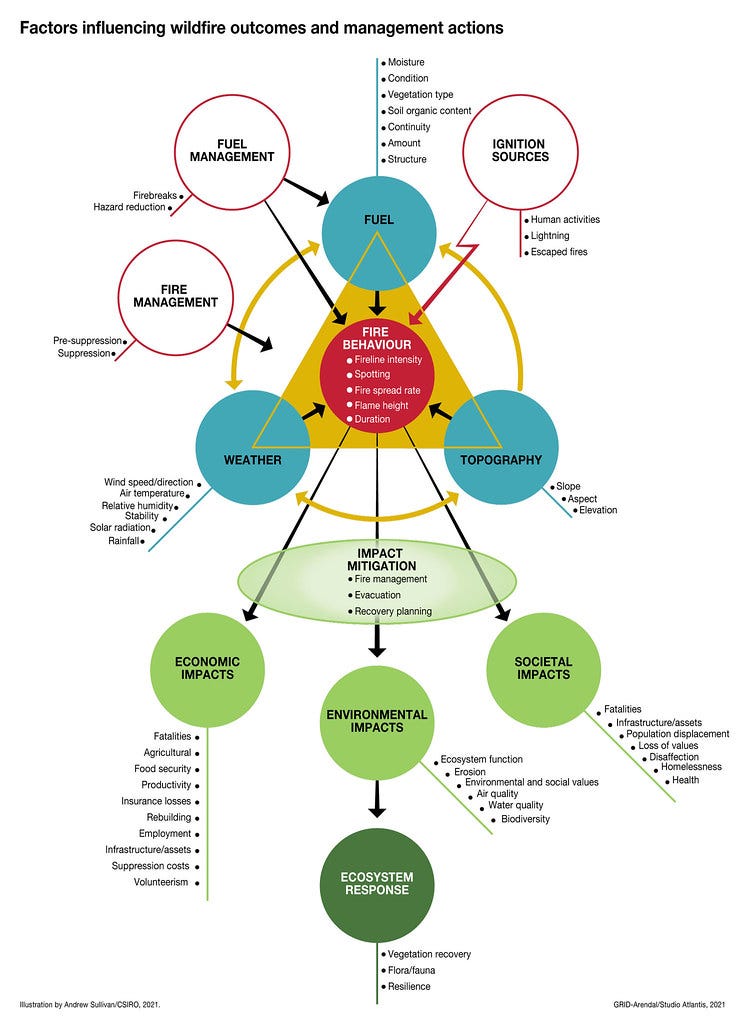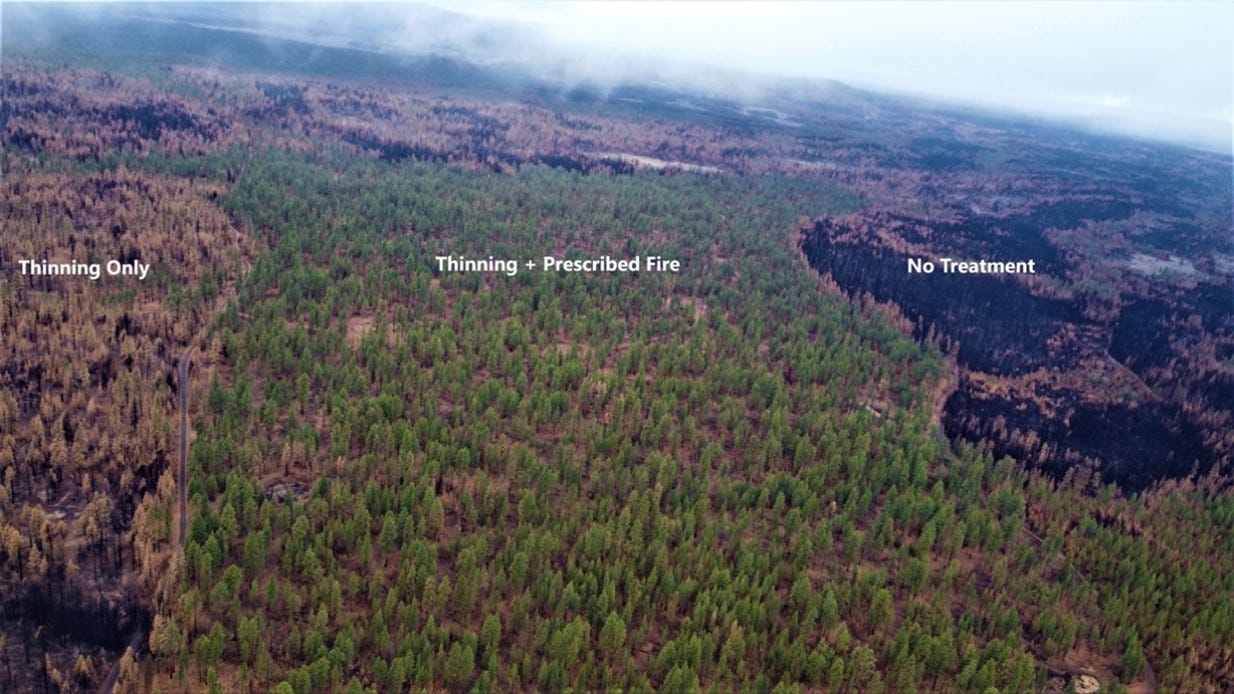🐦🔥 Building a Fire-Resilient Future: From Policy to Practice [Part 2/2]
The innovations working to prevent, detect, and respond to wildfires.
👋 Welcome back - This is the second of a two-part series on wildfire resilience. To read part one, click here.
In part one, we talked about why the wildfire crisis has hit the world so hard. Now, it’s time to discuss the ways we’re responding.
(P.S. - Stay till the end for a wildfire-tech landscape map!)
To frame our discussion today, it’s useful to break down our solutions approach into stages: prevention (before a fire), detection & response (during a fire), and recovery (after a fire). The diagram below, courtesy of Spreading Like Wildfire: The Rising Threat of Extraordinary Landscape Fires, is worth studying if you’d like a better understanding of (A) the factors that influence wildfire outcomes, and that technology can have a role in managing. and (B) the impacts that need to be addressed during recovery efforts.
Preventative Solutions
Reducing fuel loads, and modelling wildfire conditions for optimised management actions
Approach #1: Prescribed (aka controlled) burns. Most relevant in fire-adapted landscapes, prescribed burns are a method of controlling vegetative fuel load in forests that are more effective than thinning alone, and are also much more cost effective that mechanical solutions. Of the 4.3 million acres of National Forest Land (US) that the Forest Service treated to mitigate wildfire risk last year, almost half were treated with prescribed burns.
However, prescribed burns risk getting out of control, as in New Mexico in 2022, and requires careful live monitoring (such as through thermal infrared camera sensors or satellite imagery) and suppression technologies on standby.
Some technologies that are able to both ignite burns and manage them include Burnbot, whose technology system integrates ignition, containment, smoke management, and mop-up in a continuous sequence, as well as Drone Amplified, whose IGNIS and Alta X systems work to both ignite controlled fires using drones, and fire-fight when needed.Approach #2: Ignition source management. Wildfires can be sparked from countless sources, from power lines as we discussed in part one, to home electrical wires and more.
Technology fixes to address potential hazardous ignitions can be technical or behavioural. In the former category, Whisker Lab’s plug-in sensor products can monitor entire home’s electrical system to detects and mitigate electrical hazards before a fire can start, while also empowering utilities to predict and prevent grid failures. In the latter, Fire Aside makes it easier for fire agencies to engage with stakeholders in their neighbourhoods, using a suite of software products for digitising inspections, coordinating fuel removal, and applying for resilience grants when relevant.Approach #3: Vegetative load management. When power lines or railroads spark, its the surrounding vegetation that provides fuel for the fire.
Overstory and Vibrant Planet are two startups providing spatial analytics that allow land managers to prioritize and use their budget to manage high-risk areas.
Rapid Detection & Response
Squashing early flames before they turn catastrophic
Approach #4: Early detection. According to the experts who designed the XPrize Wildfire Prize, the best-case average time today between detecting to suppressing a wildfire is 60 minutes, but in extreme conditions, fires take mere moments to sprawl out of control. Remote sensing lacks the frequency and spatial resolution needed to identify small fires quickly and precisely, and come with a false positive rate of up to 40%.
In response, a number of startups are implementing on-ground sensors to detect fire early: Dryad’s wildfire sensors measure gases, temperature, humidity and air pressure, while startups like Pano.AI and Chooch use cameras and computer vision.
There have also been developments to improve remote sensing capabilities, too. Orora Technologies, for example, has launched 2 nanosatellites with their proprietary thermal infrared cameras mounted on them, to increase the frequencies of pass overs across the globe (complementing a 24 satellite constellation of partners). 4pi Lab’s existing constellation of 16 satellites, on the other hand, allows them to detect wildfires as small as 5m in diameter.Approach #5: Rapid suppression. Once fires have been detected, how can they be put out quickly, especially when they might have started in hard-to reach areas, be hard to access due to smoke-limited visibility, and pose risks to fire fighting personnel?
Helicopter start-up Rain flies autonomously to the coordinates relayed by the early detection sensors, and uses thermal cameras and computer vision to precisely deploy fire retardant. Parallel Flight Technologies has developed autonomous drones that can take heavy payloads for spot fire suppression. In addition to being able to fly through heavy smoke and at night, their drone can also deliver tools and supplies to first-responders.
Recovery
Approach #6: Specialized ecosystem rehabilitation. Following a wildfire, a number of immediate actions must be taken to minimize soil erosion and water run-off (such as by installing control structures), and correct the impacts from fire-suppression activities. In the longer-term, additional activities such as tree replanting, invasive species removals, and infrastructure repairs and reinstallations must be completed to bring the area as close to baseline as possible.
While few in number, there are a number of private sector players that specicialise in restoring fire-scarred landscapes. To prepare a fire-resilient planting prescription, for example, vertically integrated project developer Mast Reforestation maps a project’s burned acreage & historical tree cover. They then replant the project area with seeds specially bred for fire-scarred landscapes, which they produce from their own nursery.Approach #7: Parametric Insurance. We’ve written about this one before - to respond better and respect the dignity of to those who have lost their homes and assets as the result of wildfire, technology companies are designing payout systems that are triggered by physical parameters. Wildfire insurtech companies include Kettle and Delos.
Privately-funded Fire Projects and the Carbon Market
Of course, the conversation about landscape management projects almost can’t happen without mentioning the carbon markets these days. While there have been fire-specific carbon methodologies drafted (see Verra’s for example), they have not yet been used, with “generic” methodologies used more often to effectively conserve and prepare fire-prone or fire-scarred lands.
The Nisqually Land Trust, in collaboration with the Nisqually Indian Tribe, has used carbon finance to fund the acquisition and management of more than 8,000 acres of forest — converting these forests from densely packed and fire-prone timberlands to healthy forests that support biodiversity and downstream salmon habitat. In northern California, a partnership led by RenewWest is in the process of replanting more 2 million trees across 10,000 acres of land that was burned in the 2012 Barry Point Fire, funded through the sale of the carbon credits generated from the project. And in Washington state, the Climate Trust has worked with the Yakama Nation to replant western larch and ponderosa pine across more than 4,000 acres that burned in a 2015 fire.
Putting it all together - The wildfire innovation landscape at a glance
To sum things up, investing into wildfire resilience can take many shapes and forms. Impact innovator and investors have a critical role to play to help grow this ecosystem, and to respond to the needs of land managers, home owners, and the species most affected by the wildfire crisis.
As always, thanks for reading, and see you again soon.






